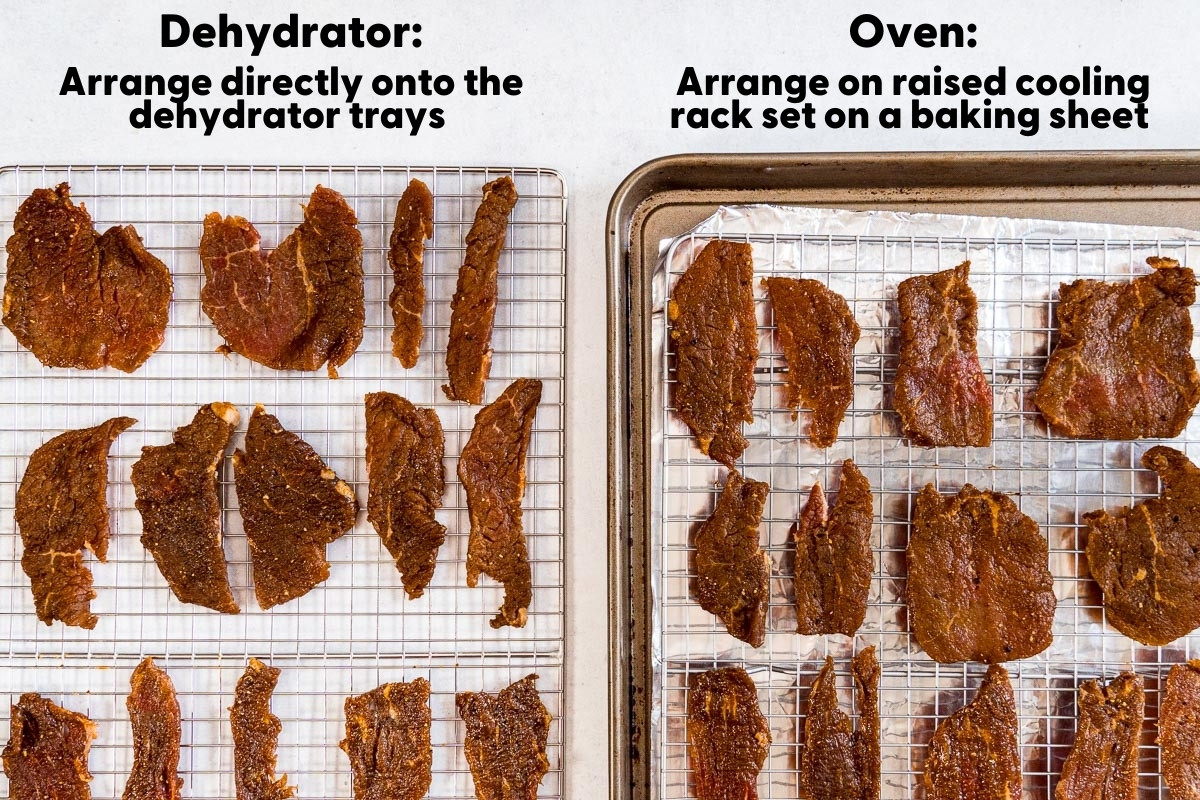What Temp to Make Beef Jerky? The Ultimate Guide for Perfectly Dried Meat
Beef jerky is an iconic snack that has been enjoyed for centuries. This flavorful, chewy dried meat makes for the perfect on-the-go protein snack. But to achieve the ideal texture and flavor, it’s crucial to dehydrate the meat at the right temperature. So what is the ideal temp to make beef jerky?
The optimal temperature range for making beef jerky is 150°F to 170°F Within this range, most experts recommend drying the meat at around 160°F to 165°F This allows the beef to properly dehydrate while ensuring safety by killing any harmful bacteria.
In this comprehensive guide, we’ll cover everything you need to know about temperature and dehydrating the perfect homemade beef jerky, including:
- The importance of temperature for safety and texture
- Step-by-step instructions for dehydrating beef jerky
- Tips to test if your jerky is fully dried
- Proper storage and food safety
- FAQs about temperature, equipment, and ingredients
Why Temperature Matters for Safety and Texture
Temperature is crucial when making beef jerky for two main reasons: food safety and texture.
Food Safety: Temperature allows you to control the growth of bacteria during the dehydration process. Beef jerky is safe to consume when dried at temperatures of 160°F and above. This heat eliminates bacteria like E. coli and salmonella.
Texture The right temperature removes moisture slowly for better texture. Too low and the meat stays rubbery. Too high and you get a crispy brittle jerky. Around 160°F creates the perfect chewy, shelf-stable texture.
Step-by-Step Instructions for Dehydrating Beef Jerky
Follow these simple steps for making foolproof beef jerky every time:
-
Prepare the Meat: Trim fat and thinly slice against the grain into 1⁄8 to 1⁄4 inch strips. Partially freezing makes slicing easier.
-
Marinate: Soak meat strips in your favorite marinade, at least 2 hours (overnight is best). Pat dry before dehydrating.
-
Arrange in Dehydrator: Lay meat strips flat on dehydrator racks without overlapping. This allows air circulation.
-
Dehydrate at 160°F: Set dehydrator between 150°F to 170°F. 160°F to 165°F is ideal. Cook for 4 to 6 hours.
-
Test for Doneness: Properly dried jerky is slightly brittle but still pliable. Test a piece by bending – it should crack but not snap in half.
Tips for Perfectly Dried Jerky
-
Use a thermometer: Monitor internal temp of meat, not just air temp. Should reach 160°F.
-
Rotate Racks: Rotate racks midway for even drying. Move strips around if needed.
-
Add Time if Needed: Thicker cuts or more moisture may require more dehydrating time.
-
Rest Before Storage: Let cool 1-2 hours before storing for moisture to evenly distribute.
Proper Storage for Food Safety
-
Store in sealed bags or airtight containers at room temp up to 2 weeks.
-
For longer shelf life (1-2 months), refrigerate or freeze. Freezing is best for long-term storage.
-
Look for signs of spoilage before eating like mold, sliminess, or an off smell. Discard if any detected.
FAQs About Making Beef Jerky
- Can you dehydrate at lower temperatures?
It’s risky below 150°F due to bacteria concerns. Always cook meat to 160°F internally before full dehydration.
- What if my dehydrator only goes up to 155°F?
Preheat in oven at 300°F for 10 minutes first to ensure food safety.
- How long does it take to dehydrate beef jerky?
Around 4 to 6 hours usually. Thicker cuts take longer. Test strips every 30 minutes once passed 4 hours.
- Do you need special equipment to make jerky?
A food dehydrator is easiest but you can use an oven on the lowest temp setting (150°F-170°F).
- Can I use a marinade or do I need a dry cure?
Either works fine! A marinade adds lots of flavor. Cure helps preservation but isn’t mandatory.
- What’s the best meat cut for jerky?
Lean cuts like eye of round, bottom round, and flank steak work well. Trim off excess fat pre-preparation.
Making your own jerky is easy and fun with the right techniques. Follow these simple tips for temperature control, food prep, dehydrating, and storage. In just 4 to 6 hours, you’ll have the most flavorful, tender homemade jerky ever – even better than the store-bought stuff!

Marinate the Beef
Add the meat to the marinade and toss until all of the pieces are evenly coated. Cover with plastic wrap (or transfer to a large ziplock bag) and marinate in the refrigerator for at least 12 hours or overnight. Toss the meat (or flip the bag) once or twice to be sure the meat marinates evenly.

Slice the Meat


How To Make The Worlds Best Beef Jerky In A Dehydrator!
FAQ
What is the best temperature to make beef jerky?
What is the best temperature to smoke beef jerky at? A low temperature of 175-185 degrees F is ideal for smoking beef jerky. This slow and steady heat ensures your jerky becomes beautifully tender and develops a deep smoky flavor without cooking too quickly or drying out excessively.
Is 200 degrees too hot for jerky?
The ideal temperature to smoke jerky at is usually between 150°F and 170°F. These lower temperatures allow the meat to dehydrate, without being traditionally cooked. You could go up to 200°F and probably be OK but any hotter and you run the risk of overly charring your jerky.Apr 13, 2022
Can you make jerky at 120 degrees?
For making beef jerky we’ll be cold smoking. Cold smoking is done at a low temperature (under 120°F (49°C)).
Is 180 too high for beef jerky?
The ideal temperature for smoking jerky typically falls between 160°F to 180°F (71°C to 82°C). This range allows for slow, even drying of the meat while preserving its flavor and texture.
